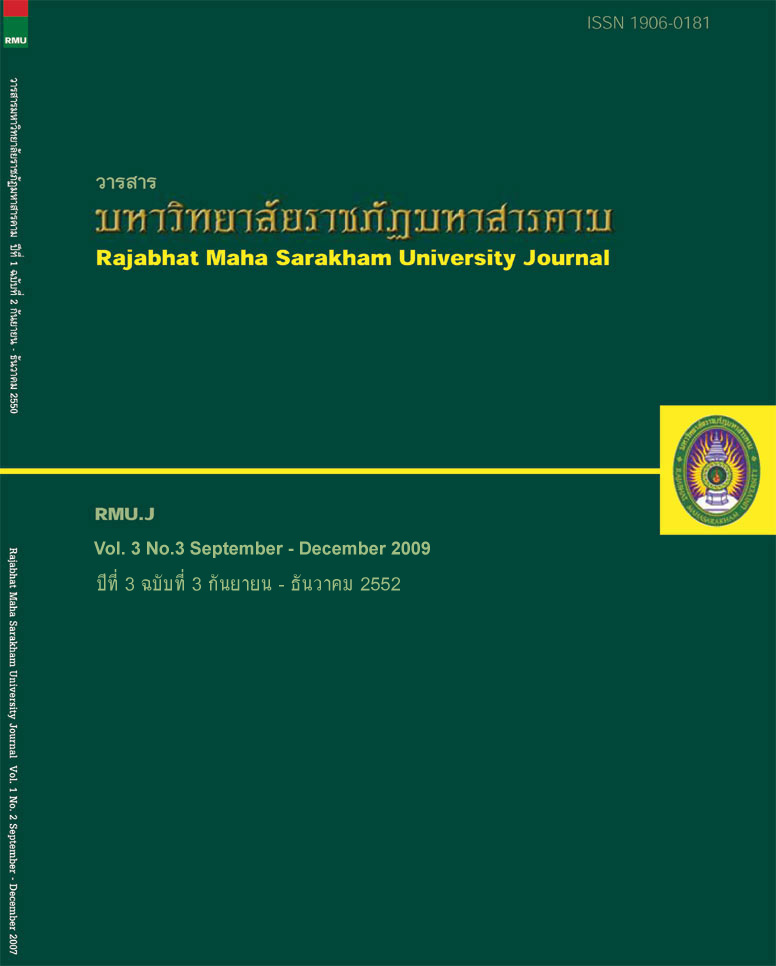การพัฒนารูปแบบการเรียนการสอนแบบร่วมมือโดยอาศัยพื้นฐานการเรียนรู้ แบบโครงงาน ผ่านระบบเครือข่ายคอมพิวเตอร์ The Development a Collaborative Learning Model Based on the Foundamental Learning Project Approach through Computer Network
Main Article Content
บทคัดย่อ
การวิจัยในครั้งนี้มีวัตถุประสงค์ ประการแรก เพื่อสังเคราะห์รูปแบบการเรียนการสอนแบบร่วมมือโดยอาศัยพื้นฐานการเรียนรู้แบบโครงงานผ่านระบบเครือข่ายคอมพิวเตอร์ ประการที่สอง เพื่อพัฒนาบทเรียนตามรูปแบบการเรียนการสอนแบบ
ร่วมมือโดยอาศัยพื้นฐานการเรียนรู้แบบโครงงานผ่านระบบเครือข่ายคอมพิวเตอร์ ประการที่สาม เพื่อเปรียบเทียบผลสัมฤทธิ์ทางการเรียนของกลุ่มทดลองที่จัดกิจกรรมการเรียนการสอนผ่านบทเรียนของรูปแบบการเรียนการสอนแบบร่วมมือโดยอาศัย
พื้นฐานการเรียนรู้แบบโครงงานผ่านระบบเครือข่ายคอมพิวเตอร์ระหว่างก่อนเรียนและหลังเรียน ประการที่สี่ เพื่อหาความพึงพอใจของผู้เรียนที่จัดกิจกรรมการเรียนการสอนด้วยบทเรียนตามรูปแบบการเรียนการสอนแบบร่วมมือโดยอาศัยพื้นฐานการ
เรียนรู้แบบโครงงานผ่านระบบเครือข่ายคอมพิวเตอร์ที่พัฒนาขึ้น และประการที่ห้า เพื่อเปรียบเทียบผลสัมฤทธิ์ทางการเรียนของกลุ่มผู้เรียนที่จัดกิจกรรมการเรียนการสอนผ่านบทเรียนของรูปแบบการเรียนการสอนแบบร่วมมือโดยอาศัยพื้นฐานการเรียนรู้
แบบโครงงานผ่านระบบเครือข่ายคอมพิวเตอร์กับกลุ่มผู้เรียนปกติ
กลุ่มตัวอย่างที่ใช้ในการวิจัยในครั้งนี้ 94 คน แยกเป็น 2 กลุ่ม ได้แก่ กลุ่มผู้เชี่ยวชาญในการประเมินรูปแบบการเรียนการสอน 3 กลุ่ม จำนวน 20 คน และกลุ่มตัวอย่างที่เป็นผู้เรียนเพื่อใช้ในการทดลองงานวิจัย 2 กลุ่ม จำนวน 74 คน ผลการวิจัย
พบว่า
1. รูปแบบการเรียนการสอนแบบร่วมมือโดยอาศัยพื้นฐานการเรียนรู้แบบโครงงานผ่านระบบเครือข่ายคอมพิวเตอร์ที่สังเคราะห์แล้วมี 4 ขั้นตอน ประกอบด้วยรูปแบบการเรียนการสอนเชิงตรรกในที่นี้เรียกว่า CoLPA model (Collaborative
project approach model) จำนวน 6 โมดูล
2. ได้บทเรียนที่ประกอบด้วยส่วนสนับสนุนกิจกรรมการเรียนการสอนแบ่งเป็น 3 ส่วน ได้แก่ ส่วนสนับสนุนตามบทบาทผู้สอน ส่วนสนับสนุนตามบทบาทผู้เรียน และส่วนสนับสนุนการเรียนรู้ร่วมกันด้วยการทำกิจกรรมโครงงานกลุ่ม
3. ผลสัมฤทธิ์ทางการเรียนของกลุ่มทดลองหลังเรียนสูงกว่าก่อนเรียนอย่างมีนัยสำคัญทางสถิติที่ระดับ .05
4. ความพึงพอใจของผู้เรียนที่จัดกิจกรรมการเรียนการสอนด้วยบทเรียนที่พัฒนาขึ้นอยู่ในระดับมาก
5. ผลสัมฤทธิ์ทางการเรียนของผู้เรียนกลุ่มทดลองสูงกว่ากลุ่มควบคุมอย่างมีนัยสำคัญทางสถิติที่ระดับ .05
The purposes of this research were to: 1) synthesize a collaborative learning model based on
the foundamental learning project approach through computer network, 2) develop a lesson of
collaborative learning model based on the foundamental learning project approach through computer
network, 3) compare the learning achievement of the students of the experimental group before and
after learning from a lesson of collaborative learning model based on the foundamental learning project
approach through computer network, 4) analyze the opinion of the students towards a lesson of
collaborative learning model based on the foundamental learning project approach through computer
network and 5) compare the achievement of the experimental group, the students who learned with a
lessons of collaborative learning model based on the foundamental learning project approach through
computer network, to the students who had regular classes. The subjects were ninety four persons who
were divided into two groups: the three groups of twenty experts for learning and teaching model
evaluation, and seventy four students who were divided into two groups for research experiment.
The results of the research were as follows:
There were four steps of synthesis to collaborative learning model based on the foundamental
learning project approach through computer network consisted of 6 modules of the logical learning
model called CoLPA Model (Collaborative project approach model).
There were developed learning model consisted of 3 parts of learning activity support: teacherbased
part, learner-based part and part of collaborative learning project approach.
The achievement in the experimental group was significantly higher at the .05 level.
The satisfaction of the students with the learning model was at a high level.
The achievement of the students in the experimental group was significantly higher than the
score of the students in the control group at the .05 level.
Article Details
1. บทความที่ลงตีพิมพ์ทุกเรื่องได้รับการตรวจทางวิชาการโดยผู้ประเมินอิสระ ผู้ทรงคุณวุฒิ (Peer Review) สาขาที่เกี่ยวข้อง อย่างน้อย 3 ท่าน ในรูปแบบ Double blind review
2. ข้อคิดเห็นใด ๆ ของบทความที่ลงตีพิมพ์ในวารสารมหาวิทยาลัยราชภัฏมหาสารคาม นี้เป็นของผู้เขียน คณะผู้จัดทำวารสารไม่จำเป็นต้องเห็นด้วย
3. กองบรรณาธิการวารสารมหาวิทยาลัยราชภัฏมหาสารคาม ไม่สงวนสิทธิ์การคัดลอกแต่ให้อ้างอิงแสดงที่มา


